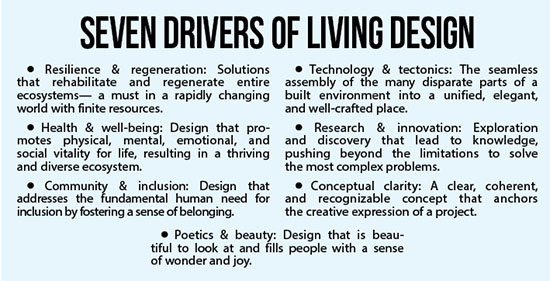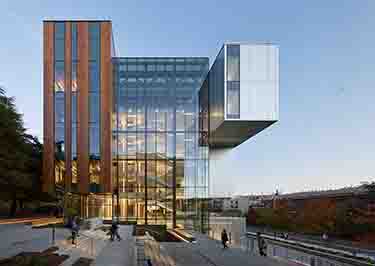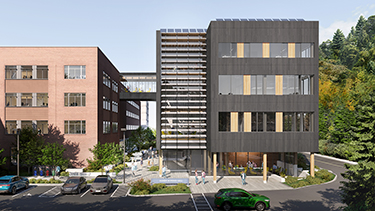|
Subscribe / Renew |
|
|
Contact Us |
|
| ► Subscribe to our Free Weekly Newsletter | |
| home | Welcome, sign in or click here to subscribe. | login |
Construction
| |
 |
October 26, 2023
Enhancing the student experience through Living Design
Perkins&Will

Kleiner
|

Harrell
|
Despite its near-endemic status, COVID-19 left its mark on the academic community. As evidenced by steep declines in high school grades and college enrollment, many students are struggling to overcome hardships spawned by the pandemic and, in some cases, adapt to a new reality of hybrid learning. According to the Surgeon General, the pandemic “exacerbated the unprecedented stresses young people already faced.”
To improve student performance and morale, and foster feelings of belonging and well-being on campus, higher education institutions are partnering with design firms to establish healthier learning environments.
Applying living design to Washington campuses
Whether it’s a building, campus, neighborhood or entire city, Living Design is a philosophy that guides the work to maximize potential by exploring synergies between systems that are mutually beneficial. Inspired by symbiotic relationships commonly found in nature, projects are carefully evaluated through seven drivers which are interconnected for a holistic approach to design, and generate previously unforeseen opportunities to meet client aspirations.
Two new regional developments have implemented this Living Design Framework: University of Washington’s Life Sciences Building and Western Washington University’s electrical engineering and computer science building, Kaiser Borsari Hall.

Embracing biology at UW’s campus gateway
Completed in 2018, the University of Washington’s Life Sciences Building serves the Department of Biology with technical teaching and research spaces designed with multiple Living Design Framework drivers in mind. Its prominent location frames a gateway to the main campus, serving as a hub for students to socialize and collaborate, addressing community & inclusion. The 207,000-square-foot lab and office building includes a public cafe and 20,000-square-foot greenhouse along the Burke-Gilman Trail, a popular biking and pedestrian artery through the city, to increase interactions between students and the broader community.
Students were actively involved in the design process of the University of Washington Life Sciences Building with UW Solar, securing over $400,000 for the building’s solar panels and cistern. They collaborated with the design team to write grants for funding, present findings to the client, and continue their involvement by leading building tours to educate the community and celebrate the fruits of their labor.
Consideration of the goal for both resilience & regeneration and technology & tectonics inspired the first-of-its-kind installation of photovoltaics — solar cells on a thin film are laminated within vertical glass fins and integrated into a glass curtain wall. In addition to shading the building to reduce unwanted heat gain, the solar fins generate enough electricity to light all four floors of offices while preserving expansive views of campus. A prime example of research & innovation and poetics & beauty, the design not only powers the building, but also transforms the appearance of the façade as the sun and clouds arc through the sky.
At the building’s core, the elevator is aptly wrapped with eight full-height tree trunks spanning six floors to celebrate biology at the heart of the building. Its carbon sequestering, live-edge wood echoes the drivers for health & well-being and conceptual clarity by forming an indoor-outdoor room with the grand Deodar Cedars located just outside the floor-to-ceiling windows, creating a warm and welcoming environment for students to study. In the evening the gaps between the trees glow with back-lit frosted glass, resembling the silhouette of the trees in a forest with the setting sun behind.
In parallel with the Living Design approach at the University of Washington’s Life Sciences Building, student health and wellness were priorities for the design of Western Washington University’s Kaiser Borsari Hall.
Zero energy and zero carbon
Western Washington University’s Kaiser Borsari Hall will serve electrical engineering, computer science, energy science and technology programs when completed in 2025.
As the first publicly funded zero-energy and zero-carbon academic building on a university campus in Washington State, Kaiser Borsari Hall will exceed LEED standards for energy use, embodied and operational carbon and use solar panels to power the facility, aligning with the Living Design Framework drivers technology & tectonics and resilience & regeneration.
In line with community & inclusion, the building will also provide physically and culturally accessible classrooms, labs and collaborative spaces for students with diverse abilities and learning styles.
Additionally, through health & well-being, natural materials, ample daylight and framed views of the outdoors were implemented, all of which are proven to reduce stress, lower blood pressure and heart rates, and promote positive effects on human immune functioning, according to scientific research compiled in 14 Patterns of Biophilic Design by Terrapin Bright Green.
The building creates a biophilic extension of the adjacent hillside nature trails, with a mass timber structure and wood cladding that continues the student’s experience walking through the arboretum (one of the prized amenities on Western’s campus). Within the building, students discover a framed view looking back to the arboretum, reconnecting with the campus landmark. This “biophilic bridge” between the natural and built environments aligns with Living Design Framework drivers for conceptual clarity and poetics & beauty.
The bigger picture
With intention and purpose during design, every project team can improve the lives of end users. Both the University of Washington’s Life Sciences Building and Western Washington University’s Kaiser Borsari Hall demonstrate how Living Design can enhance the student experience at higher education institutions.
“It was incredibly rewarding to work on this as a student and to see this project actively being constructed on campus,” said one University of Washington student. “This is the crowning achievement of my collegiate career.”
For universities, high-performing learning environments will have secondary benefits as well. Campus projects like these can work toward broader goals around climate mitigation, equity, and community engagement. Universities are massive drivers of change for good, and the Living Design framework can guide their meaningful and lasting transformations for generations to come, and leave us all feeling a bit healthier and more inspired.
Devin Kleiner is an associate principal and the director of regenerative design, leading sustainability in Perkins&Will’s Seattle office. Myer Harrell is a senior regenerative design advisor and senior project manager in Perkins&Will’s Seattle office.
Other Stories:
- Community colleges provide essential student support with affordable on-campus housing
- Coming together to build a catalyst project for WSU’s new engineering and architecture district
- Innovating student housing with mass timber and rain gardens
- Designing for urban student living
- Finding the balance in housing density and student well-being
- Going up: Seattle’s towering new vision for student housing
- Creating inclusive restrooms through design
- Going up: Seattle’s towering new vision for student housing
- Innovation Hall breaks new ground in partnerships and processes




